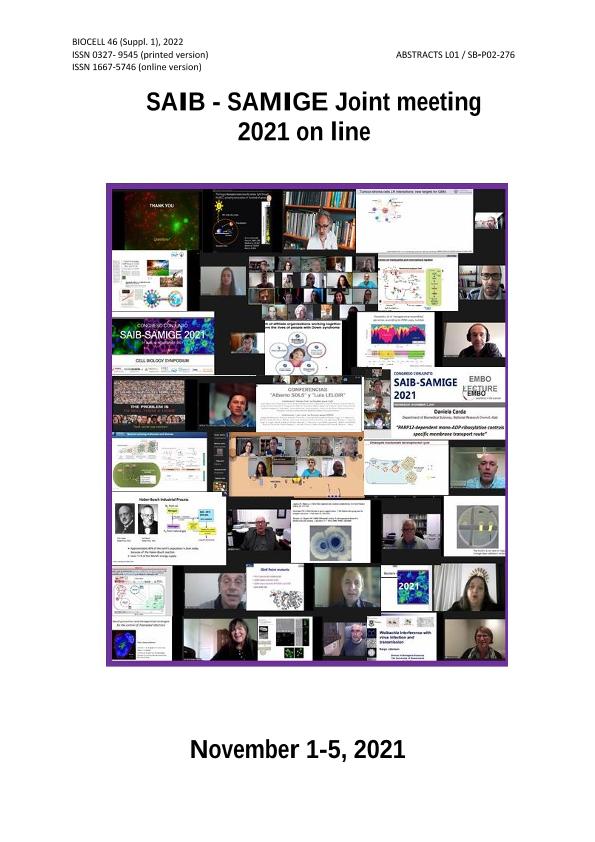Mostrar el registro sencillo del ítem
dc.contributor.author
Rias, Ezequiel Ignacio

dc.contributor.author
Carignano, Camila

dc.contributor.author
Dionisio, Leonardo Raul

dc.contributor.author
Castagna, Valeria Carolina

dc.contributor.author
Stupniki Sofia
dc.contributor.author
Gomez Casati, Maria Eugenia

dc.contributor.author
Spitzmaul, Guillermo Federico

dc.date.available
2022-07-05T10:34:04Z
dc.date.issued
2021
dc.identifier.citation
Cellular and functional mechanisms involved in hearing loss in DFNA2 mouse model; LVII Annual Meeting of the Argentine Society for Biochemistry and Molecular Biology Research and XVI Annual Meeting of the Argentinean Society for General Microbiology; Buenos Aires; Argentina; 2021; 185-185
dc.identifier.issn
0327-9545
dc.identifier.uri
http://hdl.handle.net/11336/161261
dc.description.abstract
Function impairment in the voltage-gated K+ channel KCNQ4 is the main cause of DFNA2, a non-syndromic progressive hearing loss (HL). It occurs in two phases: initially, there is a mild HL at young ages, which then progresses to a profound HL in adulthood in the last phase. Previously, we reported that outer hair cell (OHC) death may contribute to the first phase and inner hair cell (IHC) and spiral ganglion neuron (SGN) degeneration would explain the last phase of DFNA2, in a mouse lacking KCNQ4 channel (Kcnq4-/- ). Now we correlate these findings with the molecular and functional alterations in this mouse model of HL. In 3-6 weeks-old (W) Kcnq4-/- animals, using immunofluorescence (IF), we found an increase of cleaved caspase-3 (CAS-3) expression in the OHCs area in the basal turn. Moreover, gene expression analysis by qPCR in young Kcnq4-/- mice revealed that pro-apoptotic Bax transcript level was ~6-fold higher than in the WT animals, while anti-apoptotic Bcl2 gene expression was drastically reduced. Additionally, by IF, we found a lower synaptic density and mislocalization of the efferent terminals that contact OHCs from Kcnq4-/- mice. Previous studies showed that this model has an increase in the hearing threshold at low frequencies but with no decrease in IHC number. However, using the C3H mouse strain, we found loss of IHCs and SGNs in 1-year-old mice lacking KCNQ4 expression. To assess the auditory function in middle-aged mice, we initially performed the Preyer’s reflex test. We determined that ~50% of Kcnq4-/- mice did not pass the test, indicating a profound HL. Auditory brainstem response (ABR) test exhibited a significant auditory threshold shift of ~60 dB SPL in the 5.6-45.25 kHz frequency range, pointing out that the electric transmission through the whole auditory pathway is affected by KCNQ4 absence. Following this, we observed CAS-3 expression in SGNs at 1-year-old mice. IHCs neither express CAS-3 nor the autophagy marker LC3-B2. However, they showed by scanning electron microscopy (SEM), different stereocilia alterations like fusion and missing ones in middle-aged Kcnq4-/- mice. Distortion product of otoacoustic emissions (DPOAE) test revealed an auditory threshold shift of ~20-30 dB SPL in the 8-32 kHz range, indicating that OHCs function is severely impaired in these mice. Despite this, cochlear microphonic signals were detected mainly at low frequencies, suggesting a mild activity of OHCs in the apical turn. Our results demonstrated that during the first stage of DFNA2, OHCs die by apoptosis while efferent synapsis is disorganized. In the second phase, apoptosis is present in SGNs but not in IHCs which are also lost. However, we found diverse stereocilia defects, which could account for their lack of auditory signal generation in middle-aged Kcnq4-/- mice. Collectively, these findings may help to understand the cellular and molecular mechanisms underlying the biphasic HL.
dc.format
application/pdf
dc.language.iso
eng
dc.publisher
Sociedad Argentina de Investigación Bioquímica y Biología Molecular
dc.rights
info:eu-repo/semantics/openAccess
dc.rights.uri
https://creativecommons.org/licenses/by-nc-sa/2.5/ar/
dc.subject
KCNQ4
dc.subject
APOPTOSIS
dc.subject
HAIR CELL
dc.subject
DEAFNESS
dc.subject.classification
Bioquímica y Biología Molecular

dc.subject.classification
Ciencias Biológicas

dc.subject.classification
CIENCIAS NATURALES Y EXACTAS

dc.title
Cellular and functional mechanisms involved in hearing loss in DFNA2 mouse model
dc.type
info:eu-repo/semantics/publishedVersion
dc.type
info:eu-repo/semantics/conferenceObject
dc.type
info:ar-repo/semantics/documento de conferencia
dc.date.updated
2022-04-21T17:54:30Z
dc.identifier.eissn
1667-5746
dc.journal.volume
46
dc.journal.number
suplemento 1
dc.journal.pagination
185-185
dc.journal.pais
Argentina

dc.journal.ciudad
Buenos Aires
dc.description.fil
Fil: Rias, Ezequiel Ignacio. Consejo Nacional de Investigaciones Científicas y Técnicas. Centro Científico Tecnológico Conicet - Bahía Blanca. Instituto de Investigaciones Bioquímicas de Bahía Blanca. Universidad Nacional del Sur. Instituto de Investigaciones Bioquímicas de Bahía Blanca; Argentina. Universidad Nacional del Sur. Departamento de Biología, Bioquímica y Farmacia; Argentina
dc.description.fil
Fil: Carignano, Camila. Consejo Nacional de Investigaciones Científicas y Técnicas. Centro Científico Tecnológico Conicet - Bahía Blanca. Instituto de Investigaciones Bioquímicas de Bahía Blanca. Universidad Nacional del Sur. Instituto de Investigaciones Bioquímicas de Bahía Blanca; Argentina. Universidad Nacional del Sur. Departamento de Biología, Bioquímica y Farmacia; Argentina
dc.description.fil
Fil: Dionisio, Leonardo Raul. Consejo Nacional de Investigaciones Científicas y Técnicas. Centro Científico Tecnológico Conicet - Bahía Blanca. Instituto de Investigaciones Bioquímicas de Bahía Blanca. Universidad Nacional del Sur. Instituto de Investigaciones Bioquímicas de Bahía Blanca; Argentina. Universidad Nacional del Sur. Departamento de Biología, Bioquímica y Farmacia; Argentina
dc.description.fil
Fil: Castagna, Valeria Carolina. Consejo Nacional de Investigaciones Científicas y Técnicas. Instituto de Investigaciones en Ingeniería Genética y Biología Molecular "Dr. Héctor N. Torres"; Argentina
dc.description.fil
Fil: Stupniki Sofia. Consejo Nacional de Investigaciones Científicas y Técnicas. Centro Científico Tecnológico Conicet - Bahía Blanca. Instituto de Investigaciones Bioquímicas de Bahía Blanca. Universidad Nacional del Sur. Instituto de Investigaciones Bioquímicas de Bahía Blanca; Argentina
dc.description.fil
Fil: Gomez Casati, Maria Eugenia. Consejo Nacional de Investigaciones Científicas y Técnicas. Instituto de Investigaciones en Ingeniería Genética y Biología Molecular "Dr. Héctor N. Torres"; Argentina
dc.description.fil
Fil: Spitzmaul, Guillermo Federico. Consejo Nacional de Investigaciones Científicas y Técnicas. Centro Científico Tecnológico Conicet - Bahía Blanca. Instituto de Investigaciones Bioquímicas de Bahía Blanca. Universidad Nacional del Sur. Instituto de Investigaciones Bioquímicas de Bahía Blanca; Argentina. Universidad Nacional del Sur. Departamento de Biología, Bioquímica y Farmacia; Argentina
dc.relation.alternativeid
info:eu-repo/semantics/altIdentifier/url/http://www.saib.org.ar/index.php?q=node/562
dc.conicet.rol
Autor

dc.conicet.rol
Autor

dc.conicet.rol
Autor

dc.conicet.rol
Autor

dc.conicet.rol
Autor

dc.conicet.rol
Autor

dc.conicet.rol
Autor

dc.coverage
Nacional
dc.type.subtype
Reunión
dc.description.nombreEvento
LVII Annual Meeting of the Argentine Society for Biochemistry and Molecular Biology Research and XVI Annual Meeting of the Argentinean Society for General Microbiology
dc.date.evento
2021-11-01
dc.description.ciudadEvento
Buenos Aires
dc.description.paisEvento
Argentina

dc.type.publicacion
Journal
dc.description.institucionOrganizadora
Sociedad Argentina de Investigación Bioquímica y Biología Molecular
dc.description.institucionOrganizadora
Sociedad Argentina de Microbiología General
dc.source.revista
Biocell

dc.date.eventoHasta
2021-11-05
dc.type
Reunión
Archivos asociados
